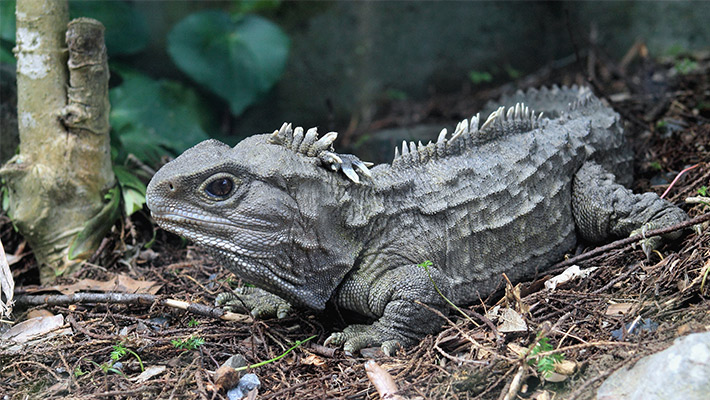Learn about Tuataras
Scientific name: Sphenodon punctatus
Classification: Least Concern
Size: Males grow up to 50cm in length and 1.5kg in weight
Distribution: Offshore islands in Aotearoa New Zealand
Diet: Carnivore, primarily eating invertebrates
Lifespan: Around 60 years, though sometimes as long as 100 years
Clutch size: 1-18 eggs
Incubation period: 12-15 months
Primary Threats: Invasive rats, climate change, habitat loss, illegal wildlife trade
Where are Tuataras found?
Tuataras are native to Aotearoa New Zealand. Once widespread across the whole country, Tuataras are now restricted to offshore islands and mainland sanctuaries where they can be protected from the introduced rodents that drove them towards extinction.
Why aren’t Tuataras classed as Lizards?
With four legs, a short neck, and a long tail, you’d be forgiven for thinking this small reptile is typical lizard. The first western scientists to describe the species thought the same, but a closer look tells a different story.
Tuataras lack the external ears of lizards, have unique dentition, and skeletal structures with more in common with fish or crocodiles. Tuataras also have a rudimentary “third-eye” on their heads, which may help them monitor day-night cycles.
Living Fossil
Tuataras are the most unique reptile on the planet, removed from all others by 250 million years of evolution. They are the only living member of the ancient order Rhynchocephalia, which diverged from other reptiles around the time of the first dinosaurs.
The Old and The Beautiful
Tuataras are well adapted to the cold of a Kiwi winter. They have the lowest body temperature of any reptile and are primarily nocturnal. Eggs can take over a year to hatch, with hatchlings taking a further 15 years to reach sexual maturity. They live around 60 years, sometimes as long as 100, making them amongst the longest living animals on the planet.
What do Tuataras eat?
Tuataras are carnivorous with a diet consisting of invertebrates like insects, spiders, and snails. They also eat small lizards and seabird eggs and chicks. Young Tuataras will hunt during the day to avoid being eaten by the nocturnal adults.
Are Tuataras threatened?
Tuataras are classed as Least Concern by the IUCN, with ongoing conservation efforts maintaining stable populations. In New Zealand, they are classed as a Relict species, with a population size and range just a fraction of historic levels. The potential invasion of rats on their island sanctuaries and the effects of climate change present the greatest threats to this species.
With ancient origins and unique biology, they are considered one of the most important global reptiles for conservation.
